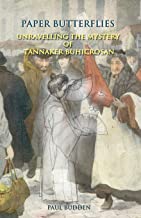Paper Butterflies
Who was Tannaker Buhicrosan?
That simple question from his granddaughter Annette Gibbs set off what her husband Brian calls a “long, hard and incredible journey.”
An initial internet search generated three hits. Enter first-rate researcher Paul Budden, who years later has given us Paper Butterflies: Unraveling the Mystery of Tannaker Buhicrosan, a meticulously documented work that probes into every detail — large and small — and answers the question of the protagonist’s true identity.
So why is this quest relevant? Perhaps no more, writes Budden, than to “shed light on what one man is capable of achieving through the simple art of reinvention.”
JAPAN’S GRAND ENTRANCE INTO WESTERN WORLD
Buhicrosan is credited with coming to London in 1885 with about 100 Japanese artisans and building the Japanese Village, where he introduced the Japanese people’s lifestyle to the general public in the United Kingdom. The village represented the beginning of British-Japanese cultural exchange among their citizens.
Budden came across Buhicrosan while researching his specialty subject Kendo, or Japanese fencing. What he discovered about the Village was that it was a different sort of exhibition than any that preceded it.
It was not, he writes, “a government-funded showcase of Japanese artifacts and memorabilia depicting high-brow Japanese culture, but a business venture highlighting real-life Japanese people going about real-life Japanese life.” The Village displayed native-style homes, shops and teahouses built from bamboo and paper, with traditionally clad Japanese occupants — in effect a true depiction of everyday life in “a highly secretive country only just emerging onto the world stage,” helping feed “the inquisitive human mind.”
Suspicion grows on many fronts, but perhaps begins when, around the time of the Village’s opening, a reporter asks Buhicrosan simply where he is from. While said to be of Dutch-Japanese origin, he conveniently deflects the question on more than one follow-up and never offers the answer. Budden goes into great detail trying to understand why a Dutch-Japanese man would have two common English middle names (Bellingham Neville), eventually suggesting that the name likely was invented.
KEY HISTORICAL DOCUMENTS CATAPULT INVESTIGATION
What gives the investigation fuel is Budden’s discovery of a Liverpool Daily Post article in 1862 that in effect calls the suspected protagonist “a seedy gentleman from the north of England — a deserter, bigamist and convict.”
The author also cites a phrase quoted from Buhicrosan’s second wife in a Liverpool Mercury account: “He was of no trade, but he could do anything.”
If you love research, admire the art and marvel at the fascinating conclusions that can be deduced from the deep dig, Paper Butterflies is the book for you. It is a decades-long quest for the truth that takes readers through every period in the protagonist’s life in an effort to substantiate or dispel it, explored from every conceivable angle by a master researcher.
“I have introduced a character very different to the one who has gone before in any previously published document,” says Budden. “It is always the stories most reluctant to be told that create the best tales.”
Visit the author’s BookTrib profile page.





